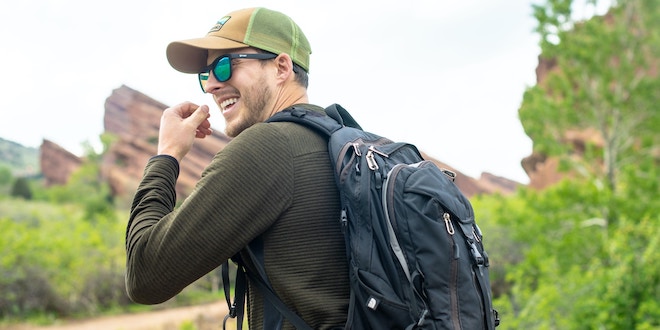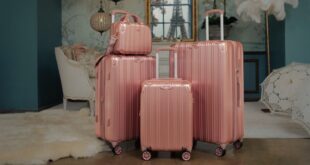Last Updated on September 8, 2023
Planning on having a little me time or does even the whole family want to have some quality time? Whatever the reason might be, if you feel adventurous, hiking is the best choice. Hiking can be physically tiring, but the view you get during it can be something else. It can be much more incredible if you choose Yosemite National Park or even the all-time favorite Grand Canyon. Sunset on the Grand Canyon could be one of the most breathtaking moments of your life. But hiking, as said, is a physical adventure and you need to be comfortable and safe to enjoy the journey.
Where to start? You ask? Well, let us start with the thing we need to see the beautiful view, your eyes. Having a pair of comfy shades can make a ton of difference and we will take a look at everything like A-Z about the shades so that you will be geared up in no time.
The Importance of UV Protection
When it comes to sunglasses, the top priority should be shielding your eyes from UV radiation.
When you’re searching for hiking sunglasses, choose a pair that blocks 100% of UV rays. The American Academy of Ophthalmology advises that sunglasses, regardless of their cost, should offer this level of UV protection.
Don’t assume that pricey brands guarantee better safety – always verify the label or product information.
Also, if you are confused, check with an ophthalmologist and get sports prescription sunglasses. Those sunglasses come with a ton of safety features like a UV shield, polarized coating, and much more. But for choosing that one also, you need some sort of knowledge about the shades like shade type, features, lens colors, etc. Don’t worry about these things, we got you covered. Let us take a look at each thing you need to know about your sunglasses.
Differentiating Sunglass Types
Not all sunglasses are suitable for outdoor adventures. When it comes to picking the right type, you’ll generally come across three main options:
Casual sunglasses – These are great for everyday use but aren’t designed for intense activities. They’re usually lightweight and offer basic UV protection.
Sports sunglasses – These are perfect for hiking because they’re lightweight yet sturdy, have a secure wrap-around fit, comfortable nose pads and temple ends, and excellent UV protection. They provide the best visibility and protection.
Glacier glasses – These have side shields and excellent UV protection. They’re meant for high-altitude hikes where there’s intense light reflection from snow and ice. They help counteract the albedo effect.
For most day hikes, sports sunglasses are your best choice. They provide a good balance of visibility, protection, and comfort, even on challenging terrain.
Just to have an idea, here is the chart that explains the UV protection in different types of sunglasses.
Source: Sunglass Hut
Key Features of Sunglass Lenses
The features of your sunglasses lenses play a significant role in both your hiking performance and your eye health. Here are some features to keep an eye out for:
- Polarized lenses – These help reduce glare from surfaces like water or snow and also enhance depth perception. They are particularly valuable for avoiding obstacles on the trail.
- Photochromic lenses – These lenses automatically adjust their tint based on changing light conditions. They become darker when exposed to bright sun and lighter when in cloud cover or shade. This versatility is beneficial for hiking in diverse terrains.
On top of that, you need to know there are two more super important features that can literally heighten your vision. First, it is an interchangeable lens. If one pair is broken, you just swap that thing with a new pair and you are good to go like nothing happened. Let’s face it, a little accident can happen while hiking and you never know.
And second is the mirror coating. This can totally change the game on your vision, thanks to the polarized coatings. Also, it adds a little bit of style to your drip.
Understanding Visible Light Transmission (VLT)
VLT stands for Visible Light Transmission, which refers to the percentage of visible light that can pass through your sunglass lenses. According to All About Vision, fresh snow can reflect as much as 80% of UV rays, effectively doubling your sun exposure.
Here are some VLT guidelines based on the tint of the lenses:
- 10-30% VLT – These lenses are most suitable for extremely bright conditions such as snow sports, beaches, and around water. They allow very little light to pass through.
- 30-50% VLT – This range is perfect for everyday use in moderate sunlight. It provides a balanced reduction in light while maintaining good visibility.
- 50-70% VLT – Lenses in this range are designed for overcast days or shaded areas. They allow more light to reach your eyes.
Selecting lenses with the appropriate VLT percentage for your surroundings is crucial for ensuring safety and achieving the best possible vision while hiking.
The Role of Lens Colors (Tints)
While UV protection is crucial, the color or tint of your sunglass lenses is also important. Different tints have various effects:
- Gray – This tint provides accurate color perception while reducing overall brightness. It’s a versatile choice for everyday use.
- Brown – Brown-tinted lenses enhance contrast and depth perception, as well as minimize glare. They are particularly suitable for winter sports.
- Green – Green-tinted lenses offer a sharp definition while efficiently absorbing light. They are commonly used for activities like golf or water sports.
- Yellow/Amber – These tints are excellent for days with low light and for increasing contrast. They aid in depth perception in foggy or shaded conditions.
- Rose/Vermilion – Lenses with this tint tone down the blue light spectrum and can alleviate eye strain. They work well on misty or overcast days.
When hiking, it’s a good idea to opt for darker tints like brown, gray, or green on bright days. Choose yellow, rose, or amber tints for trails with lower light conditions.
Also, you need to know that there are lens coatings like hydrophobic, anti-reflective, scratch-resistant, and anti-fog coatings. These are super helpful in your hiking journey and ultimately keep your eyes safe. Make sure you get the shade that has all the coatings.
Evaluating Sunglass Lens Materials
The material of your sunglass lenses affects everything from how clear your vision is to how long they last. Here’s a comparison of different lens materials:
- Polycarbonate – These lenses are durable, resistant to impacts, and budget-friendly. They’re also scratch-resistant, though they may have some slight color distortion.
- NXT Polyurethane – This material is highly impact-resistant and offers better clarity than polycarbonate. It provides excellent UV protection but tends to be more expensive.
- Glass – Glass lenses offer exceptional optical clarity and scratch resistance. However, they’re heavy and not as resistant to impacts. They also come at a higher cost.
- Acrylic – Acrylic lenses are inexpensive and extremely lightweight. However, they offer lower UV protection and are prone to scratching.
For hiking, polycarbonate lenses strike the best balance between optical clarity, weight, durability, and cost. If you’re willing to invest more, NXT polyurethane lenses offer outstanding performance as well.
Choosing the Right Frame Material
When considering sunglasses, remember to assess the frame material too. Here are the main options:
- Nylon – These frames are known for being incredibly durable, lightweight, and flexible. They don’t crack easily, even in cold weather. Nylon frames are an affordable choice.
- Acetate – Acetate frames are lightweight and comfortable to wear. However, they can be somewhat brittle when exposed to temperature changes. They often have a stylish appearance.
- Metal – Metal frames are very durable, though they can bend if pressure is applied. They might also experience chipping paint. They come in trendy styles.
- Castor-Based Polymer – Frames made from this material are flexible, lightweight, and hypoallergenic. They retain their shape well and can absorb sweat. They are on the pricier side.
For hiking, nylon frames strike the right balance between durability, flexibility, weight, and cost. If you’re looking for a fashionable touch, acetate frames can also be a good option.
Ensuring a Perfect Fit
To ensure you get the best protection and comfort, it’s essential for your sunglasses to fit properly. Here are some tips to follow:
- Choose frames with adjustable nose pads and temple arms. This allows you to customize the fit to your face.
- Ensure that your sunglasses sit snugly against your face without pressing on your eyelashes.
- Opt for lightweight materials to prevent undue pressure on your nose and ears.
- Look for frames that are stable and don’t easily shift around when you move your head.
- Test the sunglasses by bending down or jogging in place. They should stay in place and not feel loose or slip off.
Remember to take the time to try on various sizes and styles. Sunglasses that fit well shouldn’t move around during your hikes, providing you with the needed comfort and protection.
Ready to Conquer the Trails
Selecting sunglasses specifically designed for hiking is essential to shield yourself from the sun’s UV rays and other hazards while you’re on the trails.
Equip yourself with sunglasses that offer complete UV protection, such as sports sunglasses featuring polarized and mirrored lenses.
Look for lenses made from impact-resistant materials like polycarbonate or NXT polyurethane, set within durable nylon frames. With these features, you’ll be well-prepared for even the most challenging hikes.
Prioritize your eye health and make an investment in high-quality hiking sunglasses crafted for optimal performance, protection, and day-long comfort. The right pair will ensure you can explore new landscapes with vivid clarity and confidence.
Frequently Asked Questions
1. How do I know if my sunglasses provide 100% UV protection?
Check for a “100% UV protection” marking printed on the tag or product description. If it’s not clearly stated, assume the sunglasses don’t offer full UV blocking.
2. Are polarized lenses always the best choice for hiking?
While polarized lenses reduce glare, they can cause visibility issues when viewing LCD screens or surfaces like car hoods. They also may not be ideal for wearers of contact lenses.
3. How do I ensure my sunglasses won’t slip off during intense hiking?
Look for sunglasses with rubberized nose pads and temple ends to improve grip. Also, pick lightweight frames to avoid excessive bouncing. Try brands designed specifically for athletic activities.
4. Do more expensive sunglasses necessarily offer better UV protection?
No. Price doesn’t always correlate with UV-blocking ability. Some affordable brands provide 100% UV protection. Check the label to confirm, not the price tag.
5. Should I wear sunglasses in winter when hiking on snow?
Absolutely. UV rays reflect even more off snow, plus light intensity increases at higher altitudes. Sunglasses prevent snow blindness and damage from albedo.
 Travel for Food Hub The Food Blog for Travel Lovers
Travel for Food Hub The Food Blog for Travel Lovers















